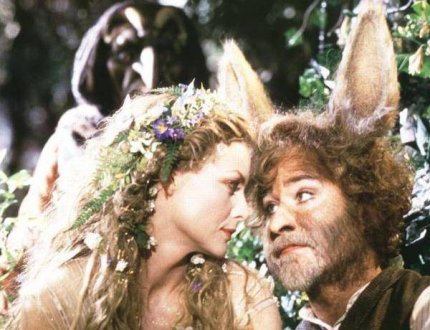There is a great deal of talk talk about bears, lions, and other beasts such as wolves in The Winter’s Tale, but by the second half of the play, we realize that the only wolf we are going to meet is Autolycus. This is not to say that this rogue is simply an antagonist, though. He is a highly complex character who falls somewhere in between the realms of good and bad: the realm of mankind.
To start, it is important to mention that the name Autolycus means “The Wolf itself” and has an extensive background in Greek mythology. In short, the mythological Autolycus was the son of Hermes and the grandfather of Odysseus. He is said to have been a great thief who had the gift of never being caught. It is interesting that this is the meaning behind his name, especially after we see him stealing fleece at sheep-shearing festival. In addition to this, he calls people “the herd” (4.4) after he completes this task. As we all know, wolves typically prey on sheep, and therefore, the sheep tend to fear them. This fact of nature would normally lead us to believe that Autolycus is evil and wishes to cause the people harm. Yet this is not the case. The people (or the “herd”) don’t fear Autolycus because he’s not really hurting anyone with what he’s doing. It is more likely that he deems these people “the herd” not because he wishes them harm, but because he is extremely clever and cunning and can constantly outwit and win these mindless sheep-like individuals over with his charming personality. It should also be noted that prior to this festival, Autolycus has been stealing sheets. There is an apparent sexual connotation here that brings to mind it the issue of Leontes, who thought Hermione was sleeping with King Polixenes. This links the latter half of the play back with the first and gives us reason to believe that Autolycus is a foil of Leontes. Autolycus uses his “profession” to his advantage and sparks a comedic element in the play, while Leontes is suffering the consequences of his false accusations and represents the tragic aspect of the play.
Autolycus appears in disguise several times (as peddler at the sheep shearing festival and later as a nobleman), tricks nearly everyone he comes in contact with by picking their pockets, and also captivates them through bawdy songs which are often about marriage, love, and sex. Shakespeare has presented us with a highly seductive character, which is likely one of the reasons why audiences and the people around him in the play seem to take a liking to him so much. His behavior is anything but honorable and he often speaks and sings crudely, but his songs are still expressed in a way that is artful and appeals to the senses and interests of his audience, and his deeds are almost overshadowed by his skillful wit and honesty with the audience. Autolycus might bring to mind Milton’s interpretation of the devil in Paradise Lost; though he is acting immorally and takes on different forms, we cannot help but also feel some sort of sympathy for and attraction toward him as a character. It helps that he really conveys the plight of the working class and shifting times on a larger level. We can see through his description of himself (4.4, 95-102) and also his actions that sometimes he works, sometimes he steals, and sometimes he begs. It is clear through many of the plays we have read (especially through Measure for Measure and King Lear, in my opinion) that Shakespeare was aware that life was not easy for most people living in 17th century England. It was a struggle to put food on the table each day, but Autolycus makes light of the situation through his humor, and would therefore be appealing to and appreciated by this large portion of the population.
In addition to this, when we learn that he used to work in the court, it becomes evident that he also serves as a link between the royal world and the pastoral world. He isn’t your typical member of the bourgeoisie. Autolycus always masters every situation he’s in and he is a jack-of-all-trades. He is not unlike Falstaff in terms of his wit and general competence; there is no doubt that he is in control and very aware of what is going on around him. I might go so far as to argue that Autolycus is what the every day workingman might dream to be. He is admirable in that he makes the best of his situation and doesn’t seem to be suffering, though he goes about it in a less than admirable manner. Even so, his character gives a sense of hope to the working class poor in the audience in Shakespeare’s time, and even today.
Through all of this, it becomes quite difficult to characterize Autolycus as a predatory wolf. He is always honest about his intentions from the start. He never presents them as honorable, and although his intentions aren’t pure in any sense of the word, they are not really “evil” either. His crimes are what we would consider relatively petty, especially when juxtaposed with the crimes of King Leontes. And we cannot forget that Autolycus’ actions eventually lead to reconciliation and harmony at the play’s end. It is undeniable that he is a complex character who is difficult to define explicitly, but we might all be unified in the notion that in all of its mystery and chaos, Act 3 scene 3 was setting us up for the entrance of a character of this nature. Through Autolycus, laughter and joy are brought into a play filled with tragic undertones, and beyond all of the fantastical elements we are presented with on stage, we finally meet a character that is truly human.



